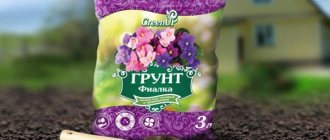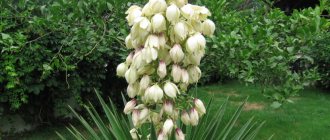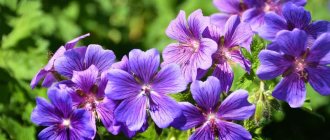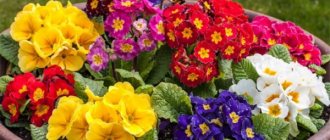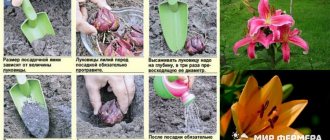Garden gerbera - what kind of flower is it, what family does it belong to?
Gerbera belongs to the Astrov family. The plant is characterized by a powerful root system; the height can reach 20-30 centimeters. Thick green leaves are collected in a neat rosette, above which the flower stalks rise.
Flower growers compare gerberas with echinacea or daisies. The difference is a wider range of colors
The average diameter of the inflorescence is 12 cm. It can bloom for 30 days. At the same time, the gerbera itself blooms for three months. During this time, up to two dozen flowers are formed on a compact bush. They are large, solitary, with a light-colored basket core. Flowers can be regular, double or semi-double.
Brief description, origin story
The gerbera is native to South Africa. Grows in the wild. Scientists talk about two versions of the origin of the name of the flower. According to one of them, the gerbera received its name in honor of Traugott Gerber, a doctor and biologist from Germany, who for many years worked in Russia and headed the apothecary botanical garden in Moscow. The second version says that from Latin the word “coat of arms” can be translated as “grass”, and since this plant belongs to the herbaceous group, it could have been given this name.
Additional Information! It was a breeder from Scotland who first noticed the bright flower: it was he who first started cultivating gerberas. This happened in one of the French provinces - Transvaal, and therefore gerbera has another name - Transvaal chamomile.
Description of the plant
Gerbera (lat. Gerbera) is a long-lived herbaceous plant from the Asteraceae/Asteraceae family. At the moment, more than 80 species of gerberas grow in different parts of the world. Beautifully flowering ornamental plants are grown on an industrial scale - for cutting, in garden plots and as potted crops. In its natural habitat, the exotic plant is found in South Africa, India, China and Madagascar.
In nature, gerberas reach impressive sizes. Large baskets of flowers look like garden chamomile, painted in warm, rich shades. If there are double flowers, from a distance they resemble large asters. According to their shape, all gerberas can be divided into four groups:
- Single flowers. Gerberas with a row of non-overlapping petals and a green disk core.
- Duplex. Plants with a double row of overlapping petals and a black, green or dark red heart.
- Crested. Of interest are two rows of overlapping petals with one or more inner rows of shorter petals. The core is scarlet or black.
- Double Crested. Gerberas with continuous overlapping rows of petals, the size of which decreases towards the center, covering it.
The home (indoor) gerbera is intended for growing in an apartment, characterized by its compact volume and height of about 30 cm. Indoor varieties have a lot of differences: different shapes of inflorescences, colors, etc. However, the main characteristics of the bright representatives of the Asteraceae are unchanged. Do you want to know what gerbera flowers look like and recognize them at first sight? So, be sure to understand the following:
| Characteristic | External signs |
| Stem | Low single elastic peduncle |
| Leaves | Delicate green, large, pinnately dissected with notches at the edges, collected in a basal rosette |
| Flowers | Large colorful baskets 5 cm in diameter; petals are double, semi-double or single, painted in all rainbow shades except blue; the core is yellow or dark |
| Root system | The rhizome is solid, formed by numerous cord-like roots |
Especially often in indoor floriculture, mini-bushes with peduncles no higher than 30 cm or a mix are grown - compositions of gerberas of different colors, planted in one pot.
Plant varieties, popular tall varieties, what they look like
Gerbera flower garden planting and care in open ground
Despite the wide variety of species and varieties (more than 1000 varieties have been bred to date), breeders continue to work on developing new ones. Gardeners prefer hybrids and varieties that are characterized by high decorative qualities. It is worth considering the most popular varieties of gerberas that are suitable for growing in open ground.
Gerber Jameson
This variety is called the main one. It was on its basis that all species known to gardeners today were bred. The Jameson's gerbera flower is located on a strong, thick stem of medium height; the leaves are large, pubescent, and feathery in shape. Inflorescences, the diameter of which exceeds 10 centimeters, have one or several rows of petals, the total number of which usually reaches 30. The color palette is varied, with the middle of the flower contrasting with the main tone. The flowering time of one flower is 21 days.
Gerber Wright
Gerbera Wrighta is usually grown to create bouquets and as an important component of landscape design. The plant has a long flowering period - it begins in the spring and continues until the onset of cold weather. The rosette consists of large feathery leaves, at the end of a long peduncle a flower is formed, more like a chamomile. The center is usually yellow or white, the petals can be of different shades:
- red;
- purple;
- yellow;
- orange;
- pink.
Most often, Wright's gerbera is used to create bright and original bouquets.
Gerbera abyssinica
This plant is more similar to medicinal chamomile than others. Found in the wild in Ethiopia. The flowers are reed-type, most often white. Young foliage has slight pubescence. The basal rosette consists of elliptical leaves.
Additional Information! Often gardeners have a question: is gerbera a perennial or annual plant? As a houseplant, the flower is grown as a perennial, but when grown outdoors in cold climate regions, it is more often cultivated as an annual flower.
Gerbera Alcor
The variety is ideal for growing outdoors. It is a small flower with narrow leaves, whose flowers are characterized by a dense cherry color. The average height of the plant reaches 60 cm.
Aldebaran and others
A narrow-petalled variety with small flowers of a pleasant pink hue. The average diameter of the inflorescences rarely exceeds 9 cm. The height of the bush varies from 50 to 60 cm. Other varieties are also popular among gardeners - gerberas are grown in dachas and gardens:
- terry and semi-double - for example, Iskra;
- large-flowered with petals of medium size - Mars;
- narrow-petaled with large flowers - Jupiter and Migar;
- broad-petaled inflorescences of small or medium sizes - Vera and Saturn.
Types and varieties of indoor gerberas
Each modern variety is a hybrid gerbera , which is bred from 2 species: the classic green-leaved and Jameson.
Varieties that have compact and low stems are suitable for the windowsill, these are:
- Festival - in the photo you can see that it has a short stem, and even larger flowers that have a variety of shades.
- Aldebaran and Alcor - they have small flowers and narrow leaves.
- Jupiter, Vega, Migar - they have narrow leaves and medium-sized flowers.
- A mix is a combination of many varieties with flowers of different shades.
Planting garden gerbera in open ground
What are gerbera flowers - what they look like and how they grow
Even short-term cold snaps can destroy a garden gerbera. Therefore, the best time to plant a flower in a permanent place in open ground begins after the threat of frost has passed.
Note! Experienced gardeners recommend planting gerberas at the same time as tomatoes, eggplants, and cucumbers.
Selecting a location
One of the most important factors necessary for the full development of a plant is the correct choice of location. The fact is that the plant will not bloom if it is planted in an area where there is not enough lighting. In addition, the place should be closed from wind and draft.
Important! In open ground, gerberas can grow either in the south of Russia or in the middle zone. Residents of other regions will have to prepare a place in the greenhouse for the plant.
How to prepare soil and seedlings for planting
The main difference between gerberas and other garden crops is that they will not grow in waterlogged soil; large chamomile does not like clay soil. It is important that the place for planting the flower is rich in magnesium, potassium and manganese. Experienced gardeners warn: when preparing soil for gerberas, you should not add any type of manure to it. Instead, add a small amount of compost.
Plants must be provided with sufficient lighting, otherwise the peduncles will stretch out and the flowers will be small
Before planting gerbera seedlings in the country, prepare the seedlings. First, it should be examined. There should be no white coating, brown or yellowish-brown spots on it. It should not be elongated. The normal leaf color is deep green. In order for the seedlings to adapt to new conditions, they must be taken outside for the whole day.
Gerbera transplant
The bright life span of indoor gerberas is short, only 3–4 years. Then the bushes lose their decorative properties and bloom less frequently and sparingly. Through reproduction, young specimens are grown, and old ones are thrown away. Therefore, you will only have to do the transplant a couple of times.
Replanting after purchase
The first transplant is carried out soon after purchasing the flower, since a store-bought transport pot and the substrate in it are not suitable for long-term cultivation of the flower. Plan this procedure 2-3 weeks after purchase - this time is enough to adapt the gerbera to new conditions. You will need to remove the flower from the shipping pot and shake off or scrape off as much of the store-bought substrate as possible with a wooden stick. Do not trim or pick off the gerbera roots. It is better to disinfect the prepared pot, even if it is completely new.
There should be drainage holes at the bottom of the pot, then a layer of drainage made of expanded clay (pebbles, crushed stone, pieces of polystyrene foam, small ceramic shards) at least 2-3 cm thick. Next comes a layer of fresh, preferably sterilized substrate (about a third of the pot) . Place the bush on the substrate in the center and carefully fill the roots along the edges of the pot. Make sure that the root collar is not buried. The root rosette should rise 2-4 cm above the ground surface.
The transplant should be done during the dormant period, when the gerbera does not bloom. If you were given a pot of blooming gerbera, then it is better to leave it in the same pot so as not to disturb the flowering process and not spoil your pleasure. Replant after the plant has finished flowering.
Planned transplant
You will have to plan the next transplant for next year, when the gerbera has grown enough. The optimal time for transplantation is the end of the dormant period. This is approximately from the end of February to mid-March. Some gardeners recommend replanting after flowering has ended, somewhere in late autumn. We are for the first option.
- Replant the gerbera using the transshipment method, while trying to disturb the roots as little as possible.
- After transplanting, compact the substrate and water it moderately. Place the flower pot in the shade for 3–5 days to prevent direct sunlight.
- If after a week the transplanted gerbera bush does not look cheerful, as if it has not yet recovered from stress, spray the surrounding air and build a greenhouse around the flower, for example, from polyethylene. Let the plant in it grow stronger and begin to grow. Get rid of accumulating condensate in a timely manner by ventilation, so as not to provoke the development of rot.
This may be interesting: Types and varieties of indoor Bougainvillea
Carry out the first feeding no earlier than a month after transplantation. Use mineral nitrogen-containing fertilizers that stimulate the flower to actively grow green mass.
How to care for perennials
Speaking about how to grow gerberas, one cannot help but say that the culture loves fresh air, is demanding of bright lighting, moderate humidity levels, and timely application of fertilizing.
Watering rules and humidity
Fuchsia growing and care in the garden, in open ground
The culture prefers small but frequent watering. During the growing season, garden gerberas require more water, but it is important to ensure that there is no stagnation of moisture at the roots.
A number of rules must be followed:
- water should not get on the socket;
- Avoid getting water on the leaves;
- use only warm water - 26-28 ℃ above zero.
Important! Experienced gardeners recommend the following watering scheme: four days of moist soil should be followed by two days of dry soil.
For any gerbera in the garden, cultivation and care should be as close as possible to the natural conditions of warm countries. Flower growers note: it is not advisable to spray gerberas, but the level of air humidity should be high - about 65-75%, but should not exceed 85%.
The optimal soil for the crop is weakly acidic.
Before planting a gerbera, the place for it should be treated with phytosporin to prevent fungal diseases.
Fertilizing and soil quality
30 days after transplanting the flower to a permanent place, you can apply the first fertilizers to the soil. Flower growers recommend applying mineral fertilizers once every 14 days from March until autumn.
Organic products are prohibited. Flowers will react negatively to compositions that contain chlorine, cow or bird manure. Because of such fertilizers, root collar rot may develop and the plant will die.
Pruning and replanting
After the plant has flowered, it is necessary to carry out the pruning procedure. Dry leaves and flower stalks on which the flowers have already faded should be removed. It will not be superfluous to trim off excess leaves - this is necessary to stimulate new flowers.
It is best to replant gerberas in the spring. The soil should be light and drained. The roots should be trimmed, leaving only 10-15 cm. Before replanting, the root collar of the plant should be treated with a slightly pink solution of potassium permanganate.
Growing seedlings
First of all, you need to select high-quality planting material, but keep in mind that gerbera seeds remain viable for no more than 10 months. You can collect the seeds yourself if you already have these flowers in your garden. But this is a troublesome matter, since in this case you will have to pollinate the plant yourself. Therefore, it is better to purchase planting material in a special store.
Seeds are planted from January to March. Please note that flowers that were grown from seeds will not begin to bloom until 11 months after planting. Therefore, it is advisable to sow garden varieties in the spring.
Caring for gerberas in winter
Breeders have managed to develop varieties that can withstand temperatures down to -10 ℃, but they also need shelter for the winter.
Speaking about whether gerbera is a perennial or an annual, it should be said that everything depends on the climatic conditions of the region. In regions where winters are harsh, it is recommended to transplant the plants into containers - and move them indoors. At home, plants will definitely survive the winter. In the southern regions, it is enough to trim the flower stalks, stop applying fertilizers, and reduce watering. Before winter, bushes should be covered with straw and fallen leaves.
Flower growers advise placing pots with gerberas in rooms with low air humidity and stable temperatures
What can destroy seedlings
As you already understand, gerbera is a delicate plant that requires special care. Therefore, its seedlings are quite easy to destroy. To avoid this, you must remember what exactly can have a detrimental effect on their condition:
- water is too cold for irrigation;
- increased air humidity in the room;
- deviation of the air temperature in the room from the required values;
- low light;
- too much deepening of the root collar during picking.
Flower propagation methods
The plant can be propagated in several ways. The main ones are by dividing the bush and seeds.
Reproduction by dividing the bush
In early spring, you need to dig up a bush and divide it into several shoots. Each one should have leaves. The shoots should be planted in the ground so that the rosette protrudes no more than a centimeter.
Propagation by seeds
Speaking about how to get bright gerbera flowers, how to grow them from seeds, one cannot help but say that this process is energy-consuming. Already in January-February, seedlings are planted. The seeds are soaked in water, never allowing them to dry out. After 4-5 days, when the seeds begin to hatch, they are moved to moist, loose soil. The soil is sprinkled with sand on top and covered with film. From time to time the soil is moistened - it is best to do this with a spray bottle. In a week the first shoots will appear.
General landing rules
Regardless of the method of obtaining planting material, the general rules for planting it should be followed. This applies to the characteristics of the soil and the choice of location for the plant. Thus, it is customary to plant gerbera seedlings in already warmed soil, which should be moderately drained. The landing site should be sunny. Gerbera tolerates partial shade well, but only if it occurs in the first half of the day. The plant requires frequent watering only during the growing season. But you can understand how to plant a Lavender flower by reading the article.
Watering should be done only at the root, trying to avoid getting on the foliage.
When talking about how to care for gerberas, it is important to take into account the characteristics of the region. It is possible to use this flower as a perennial plant only in those regions where summers are hot and winters are warm and mild. Then in winter it is enough to cover the plant with a thick layer of straw, dry leaves or spruce branches.
Growing problems, diseases and pests
Most often, gerberas are susceptible to fungal diseases. If the fungus has infected the root system of the plant, the flower should be transplanted to a new location, having previously treated the soil and roots of the plant with antifungal drugs. The drugs will also help get rid of gray rot.
Additional Information! Fungicides will help in the fight against powdery mildew. If the root collar begins to rot, you should reduce watering and begin to loosen and mulch the soil.
Among the most common causes leading to the disease, experts identify:
- excessive watering - because of it, fusarium and late blight develop;
- lack of moisture – leads to the appearance of spider mites;
- aphid attacks - the plant begins to wither.
To prevent gerbera leaves from turning pale, they should be shaded on sunny days.
Gerbera may stop blooming when it doesn't get enough sunlight or the soil contains too much nitrogen. If the leaves begin to turn yellow and dry out, the plant is not getting enough moisture.
Gerbera daisies can become a gardener's real pride and the main decoration of the garden - all you need to do is know how to properly plant seedlings in a permanent place and how to care for them. All the efforts and time spent will certainly be worth it - the gerbera will delight you with lush flowering and a real riot of colors.
The process of planting seeds
The seeds are deepened no more than 0.3 centimeters under the ground. It will be better if you simply spread them on the surface of the moistened soil, and sprinkle a thin layer of dry soil on top. The distance between seeds should be approximately 3-5 millimeters. Such density is not scary, since their germination rate is low.
Next, you need to cover the containers with glass to create a kind of greenhouse. Remember to remove the glass from time to time to remove condensation. At the same time, you can moisten the soil. To do this, it is better to use not a watering can, so as not to wash the seeds, but a spray bottle. The air temperature in the room should not be lower or higher than +18 degrees.
In just a week you will be able to see the first shoots. This means that the coating can be removed. Two weeks after the seedlings emerge, the first true leaves will appear.
Next you should do the picking. It is carried out when four true leaves appear on the seedlings. Each seedling will need to be transplanted into a separate pot with a diameter of 8-10 centimeters. The air temperature in the room where the seedlings will be located should be kept at +18-20 degrees. The pots should be in a well-lit place, but not in direct sunlight. Please note that some seedlings may stretch. This means they don't get enough sunlight. In this case, you will have to correct the situation by installing fluorescent lamps above the gerberas. Also, drafts should not be allowed in the room. If you really want to grow gerberas, you need to be extra careful when it comes to watering. They can only be carried out when the top layer of soil is completely dry. Moreover, water for irrigation should only be at room temperature.
Gerbera pot: which one to choose?
We should also talk about a pot for growing gerbera. It is known that it is undesirable to use pots after other plants, as they may contain disease spores. Therefore, you need to replant the gerbera into a new pot.
The pot must meet the following requirements:
- Must be free
- It is necessary to have a tray that will not come into contact with the pot (pallet on a stand)
Important: Although the plant does not like overwatering, a certain humidity must be maintained constantly. The right pot helps in this matter. Place pebbles on a tray and pour water over them. If the tray is not in contact with the pot, the roots will not absorb the water, but it will still be a moist environment.

